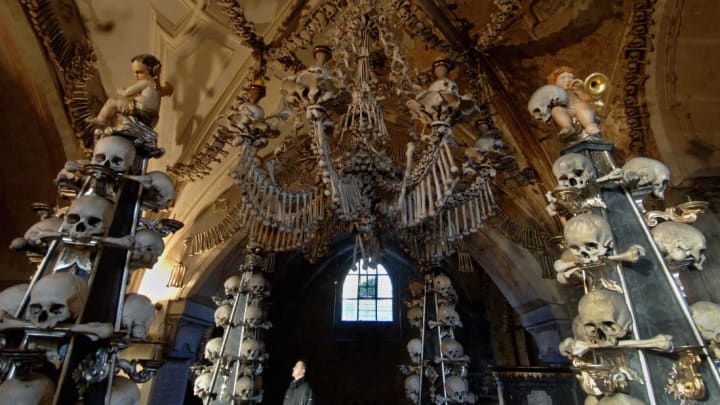About an hour's drive east of Prague, the Czech Republic's Sedlec Ossuary—known as Kostnice Sedlec in Czech, and nicknamed the Bone Church—has become a macabre pilgrimage site for roughly 400,000 tourists a year. The centuries-old Roman Catholic chapel boasts a series of stunning decorations, all made from skeletons. Read on for seven facts about the past, present, and future of this remarkable (and remarkably dark) attraction.
1. The Sedlec Ossuary is home to the remains of more than 40,000 people.
The Bone Church started out as part of a Cistercian monastery founded in 1142 [PDF]. According to legend, around 1278, a local abbot made a pilgrimage to Jerusalem, after which he brought back a handful of soil from Golgotha—the site of Jesus's crucifixion. Upon his return, the abbot scattered the soil over the monastery's cemetery as an act of consecration. Soon enough, Sedlec's cemetery became a highly desirable place to be buried, and the Black Death epidemics of the 14th century only added to the number of burials. The Hussite Wars (1419-1434) added another approximately 10,000 bodies. Before long, the cemetery groaned under the weight of all its occupants, and an ossuary—a receptacle for bones—was constructed to hold the "excess" bodies in the basement of the cemetery chapel. The decorations in the Bone Church were constructed from these extra bones, primarily in the 19th century.
2. According to legend, a half-blind monk first arranged the bones at the Sedlec Ossuary into pyramids.
If you visit the underground chapel today, you'll notice pyramids of bones in each corner. Now there are four, but once there were six—all allegedly arranged by a half-blind monk in the early 16th century. Supposedly, once he had finished arranging the skulls, femurs, etc. to his liking, he regained his sight.
3. The Sedlec Ossuary is home to a chandelier made with (almost) every bone in the human body.

Perhaps the most famous feature of the Bone Church is the 8-foot chandelier said to contain almost every bone a human being can grow. The chandelier is the work of František Rint, a Czech woodcarver hired around 1870 by the Schwarzenbergs, a powerful noble family that had purchased the property in the late 1700s. Rint—who may have trained in Italy and been inspired by the skeletal decorations in some crypts there—disinfected the bones and bleached them with chlorinated lime to give them a uniform appearance. Macabre as it may seem, the chandelier is not intended as a ghoulish decoration: It's a memento mori, a reminder of death, intended to encourage believers to consider their earthly fate and relationship with God.
4. The Sedlec Ossuary is also home to a family crest made out of bones.

The Schwarzenbergs weren't above a little family pride. Rint also fashioned a Schwarzenberg coat of arms out of bones, which is fastened to the railing over one of the pyramids. The bottom right features a raven plucking the eye out of the head of a Turk (all constructed from bones, of course). According to author Paul Koudounaris's book Empire of Death, this feature commemorates the victory of Adolf Schwarzenberg over Ottoman forces in 1598.
5. The Sedlec Ossuary's chapel includes the artist's signature—in bone.

There's no doubt about who created most of the chapel's morbid decorations—which also include oversized monstrances, chalices, sunbursts, and garlands—because Rint signed his handiwork. If you visit the ossuary, you can see the signature (made from hand and arm bones) near a staircase down from the main level.
6. The Bone Church has starred in its own short film.
In 1970, the centenary of Rint's undertakings, the Czech surrealist filmmaker Jan Svankmajer came out with Kostnice (The Ossuary), a 10-minute, black-and-white short film celebrating the site. The original narration, which included explanations from a tour guide, was deemed unacceptable by Communist authorities (all the death and decay reportedly seemed a little too subversive). Instead, the audio track was replaced with piano music and the recitation of the poem "To Paint the Portrait of a Bird" by Jacques Prevert.
7. The Sedlec Ossuary is under renovation.
Over the years, the dampness of the underground site—not to mention the stampede of visitors—has taken its toll. The Sedlec Ossuary has been under renovation since 2014, and the entire church is in the process of being strengthened and restored. The famed bone chandelier was dismantled, cleaned, and put back together in 2016. As of February 2019, volunteers were at work dismantling and cleaning the pyramids of bones.
While the renovation is ongoing, the site is generally open during repairs.
